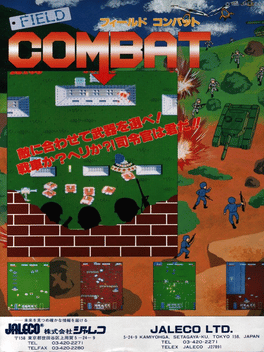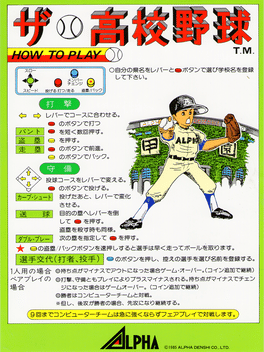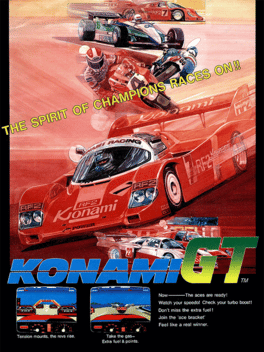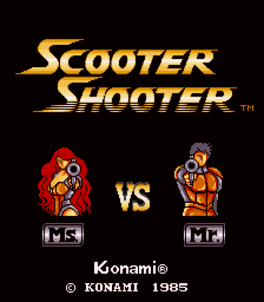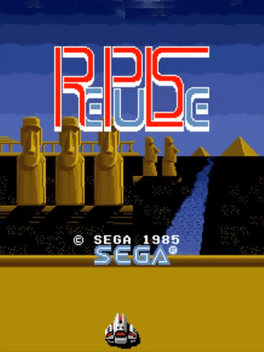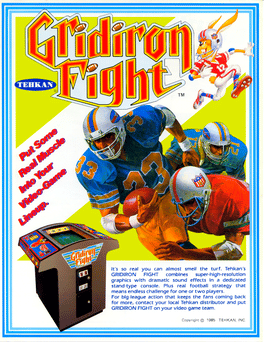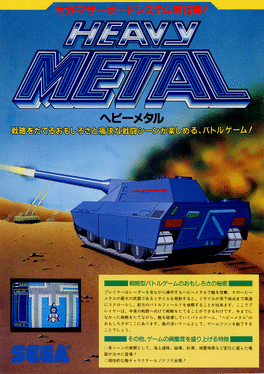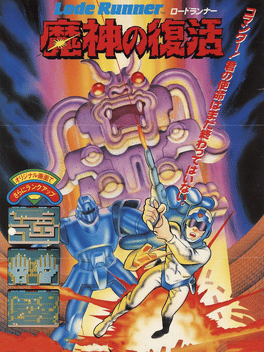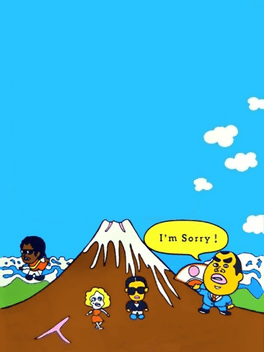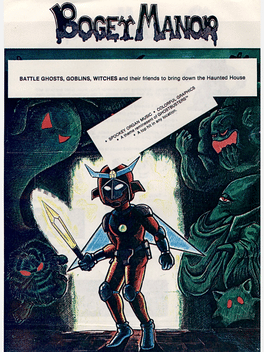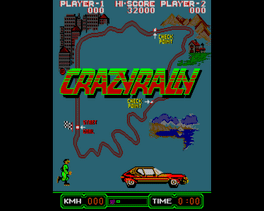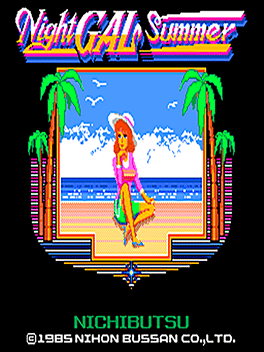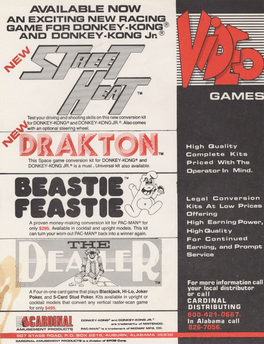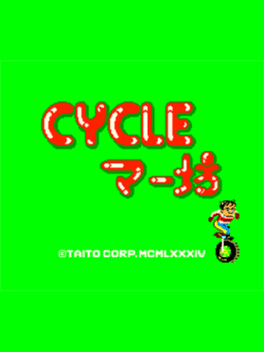New Arcade Games - Page 108
-
Field Combat
1985
Field Combat
1985
Field Combat is a 1985 shooter video game developed and published by Jaleco for arcades. -
Splendor Blast II
1985
-
The Koukou Yakyuu
1985
-
Vs. Hogan's Alley
1985
Vs. Hogan's Alley
1985
Vs. Hogan's Alley is a Nintendo VS. System (Arcade) port of Hogan's Alley (NES). -
Konami GT
1985
Konami GT
1985
Konami GT, originally known as Konami RF2 - Red Fighter, is a 1985 racing video game developed and released by Konami, using their GX400 arcade architecture. The player drives a sports car which must reach various checkpoints without running out of fuel. A turbo mode (activated by the gear shift) increases the car's speed but uses more fuel and puts the player at a higher risk of hitting an obstacle. Fuel power-ups can be found on the road which the player must pick up to make it to the final checkpoint. The original title RF2 is a reference to Konami's 1984 arcade game Road Fighter, and thus this may be considered an unofficial sequel. RF2 was a commercial success in Japanese arcades. The series was followed in 1996 by official sequel Midnight Run - Road Fighter 2. Konami GT was made available on Microsoft's Game Room service for its Xbox 360 console and for Windows-based PCs on October 6, 2010. -
Scooter Shooter
1985
Scooter Shooter
1985
Scooter Shooter is a horizontal-scrolling shooter arcade game developed by Konami in 1985 with competitive play against either a computer opponent or another player. -
Repulse
1985
Repulse
1985
With a spaceship, the player shoots several kind of robotic enemies and spaceships. At the end of every stage (except for the first one), the player meets a huge enemy spaceship as the stage's boss. Player's spaceship is equipped with a limited force shield which allows it to resist any kind of attack, though energy drains both while its active and whenever the ship gets hit during. Power-ups are dropped by ally helicopters and spaceships, that bring to the player a new shot (much faster than the normal one) and refills his force field's meter. -
Gridiron Fight
1985
Gridiron Fight
1985
Gridiron Fight is a two-dimensional top-down scrolling American football game in which the player(s) control the virtual player on their team who is closest to the ball, with the trackball determining the speed and direction at which the player runs. A single push-button labelled "Kick" causes the virtual player in possession to release the ball with the same force and direction in which he is currently running. (This button is duplicated on either side of the trackball for left or right-handed players.) The Player 1 (red trackball) side contained two additional push-buttons for choosing between Single or Two-Player games. Before each play, players are invited to select from a variety of formations, e.g. "Sweep" or "Draw". The formation selected is displayed on a seven-segment LED on the player's control panel. -
Heavy Metal
1985
-
Hex Pool
1985
-
Lode Runner III - The Golden Labyrinth
1985
In 1985, Irem released the third of four arcade conversions of Lode Runner. This third version, like the second contained 30 selected levels from the 150 original levels. It is pretty much the same game as the previous version, with different levels. -
I'm Sorry
1985
I'm Sorry
1985
This action game stars a caricature of former Prime Minister of Japan, Kakuei Tanaka. The title is actually a play on the Japanese word for Prime Minister, "Sori". The game satirizes Tanaka's greed by making the goal of the game acquiring gold bars. This arcade game made it into some of the United States arcades. The goal is for the greedy protagonist to collect all the gold bars while jumping over or defeating various enemies and obstacles in each maze-like level. Some of these enemies are: Giant Baba (a Japanese wrestler), a moonwalking Michael Jackson, Madonna, Japanese comedian Tamori, Carl Lewis, moving statues (activated when passed by). Some obstacles include: Gates, "fire" hydrants, safes (making it difficult to gain access to the gold), a rolling barrel, conveyor belts, and a swimming pool with platforms ranging in size and strength. When you collect all the gold in a given level, you must cash it into a building (labeled "out" when the level begins and "in" once you retrieve all the gold) to beat the lev -
Bogey Manor
1985
Bogey Manor
1985
You play as a young ghost hunter boy who runs around a haunted house. Your objective is to destroy with your sword all the crystal balls that are in the house, you must go through all the floors and go through the doors guided by the map at the top of the screen in a time limit without getting caught by the ghosts, frankenstein, witches and other creepy creatures. With the help of your magic glove can freeze ghosts for a short period of time to later hit them with the sword. Once you've destroyed all the crystal balls, the haunted house starts falling apart, and you must run for your life towards the exit to win the stage. You can transform into a super hero, entering through the flashing door to grab special items. -
Galivan - Cosmo Police
1985
'Cosmo Police Galivan' is an action game that was released from Nichibutsu in 1985. Players are transformed into 'Galivan' with putting in hand the power crystal, to destroy the universe criminal organization 'Aku'. -
Crazy Rally
1985
Crazy Rally
1985
A top-down, vertical scrolling racing game in the style of other rally games. The route consists of three stages with a variety of obstacles including tight turns, accidents on the highway and oncoming traffic. Rival cars perform special attacks including smoke clouds and spraying oil slicks on the road. -
Night Gal Summer
1985
Night Gal Summer
1985
Evening Girl is a mahjong game from the arcade platform. It combines interesting elements with adventurous gameplay. It has given us a lot of fun after it was released. If you are also a loyal fan of this game, you must not miss it . -
Fighting Basketball
1985
-
Drakton
1985
Drakton
1985
Drakton was produced by Epos Corporation/Magic Conversions Inc. in 1984. Epos Corporation/Magic Conversions Inc. released 2 different machines in our database under this trade name, starting in 1984. Other machines made by Epos Corporation/Magic Conversions Inc. during the time period Drakton was produced include IGMO. An outer space battle game where the players conrtols the Drakton Fighter which must destroy enemies with plasma torpedoes throughout various sectors. -
Gladiator 1984
1985
Gladiator 1984
1985
This is actually a racing game. Ride on your horse and jump over obstacles or avoid them with your chariot. -
Cycle Maabou
1984
Cycle Maabou
1984
A man on a monocycle bounces on objects and traverses through other stages. Arcade game by Taito.
